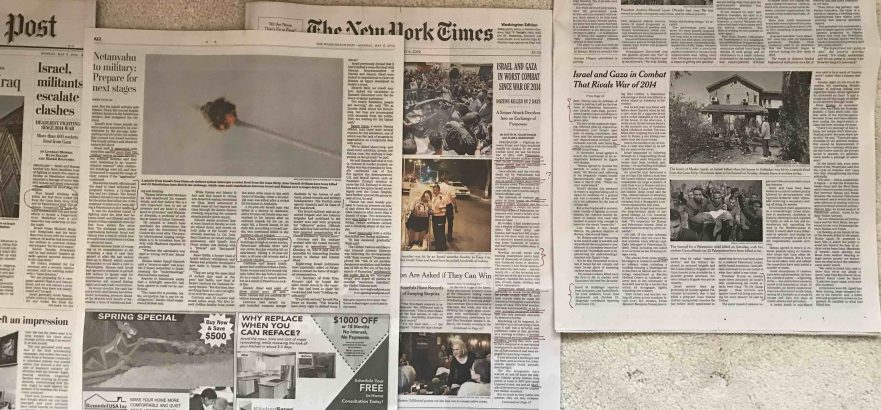(Special edition for reporting on Gaza-Israel fighting. Can be adapted for other purposes.)
We are pleased to produce this handy checklist, that ambitious young journalists can follow if they want to get ahead in U.S. corporate media.
The rest of us can use it to play “Anti-Palestinian Bias Bingo” whenever we read news reporting in such outlets. (The Washington Post example pictured above, from May 6, 2019, scored nearly a Full House! Well done, the WaPo!)
- Always describe Israel’s military action as “responding to” some prior Palestinian action (see #10 and #11 below.)
- Use skewed ways to report the casualties on each side. This can include: (a) Which kinds of casualties are counted (deaths, or deaths plus injuries) or (b) How the casualties are described (“died”, vs. “killed” by unidentified assailant, “killed” by identified assailant and written in the active voice);
- Deploy humanizing details regarding casualties– such as names, biographical details, comments from grieving relatives– in a way that underlines that each Israeli person is worth a lot more of your reader’s attention than each Palestinian person.
- Use numerical legerdemain to create a misleading picture of the balance of the violence used by each side, e.g., write about a “barrage of 600 rockets” and “airstrikes on more than 300 targets” in a single sentence, with no mention of the relative destructive power of each form of attack.
- Use the word “targeted” as frequently as possible to describe Israel’s military actions, and present as fact any assertions from Israeli military spox that a given person was a “militant” (whatever that means—it seems distinct from the international-law category of “combatant”) or that a given structure was used for combat-related purposes.
- Deploy photos in a way that supports #2 – #4 above and that omits as much as possible any representation of the scale of destruction and loss on the Palestinian side.
- Include in your reporting an assertion that the Armistice Line is an international border.
- Deploy quotes from political actors, “vox-pop” people, and “analysts” in a way that assumes the integrity and truthfulness of Israeli interviewees by including more quotes from such people and accepting their assertions at face value, while constantly casting doubt on the veracity of assertions from Palestinians (or the value of having many quotes from such people, at all.)
- Be sure never to mention the fact of Israeli government censorship of your report.
- Mention Israel’s 13-year siege/blockade of Gaza either not at all or only in the latter third of your article.
- Do not mention that under international law Gaza is territory under Israeli military occupation and therefore (a) Israel’s collective punishment of its people is a grave breach of the Geneva Conventions and (b) Gaza’s residents have the right to resist the occupation including through fighting in any legitimate way.
- Give no hint that you’ve tried to apply an international-law perspective to the events described, e.g., by questioning Israeli military spox’s definition of a “legitimate” target.

